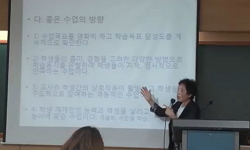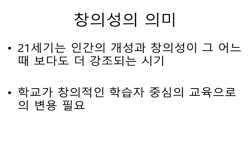本研究の目的は、日本語を学習する韓国人大学生を対象として持続可能な開発のための教育(ESD)を目的とした内容言語統合型学習(CLIL)を実施するための理論的枠組みを構築することと、そ...
http://chineseinput.net/에서 pinyin(병음)방식으로 중국어를 변환할 수 있습니다.
변환된 중국어를 복사하여 사용하시면 됩니다.
- 中文 을 입력하시려면 zhongwen을 입력하시고 space를누르시면됩니다.
- 北京 을 입력하시려면 beijing을 입력하시고 space를 누르시면 됩니다.

持続可能な開発のための教育(ESD)を目的とした内容言語 統語型学習(CLIL)のモデル開発 ― 韓国人大学生を対象とするCLILの理論的枠組み構築と妥当性の検証 ― = Development of a Content and Language Integrated Learning (CLIL) Model for Education for Sustainable Development (ESD): Construction and Verification of a Theoretical Framework for CLIL Targeting Korean University Students
한글로보기부가정보
다국어 초록 (Multilingual Abstract)
本研究の目的は、日本語を学習する韓国人大学生を対象として持続可能な開発のための教育(ESD)を目的とした内容言語統合型学習(CLIL)を実施するための理論的枠組みを構築することと、その妥当性を検証することである。グローバル化の進展は地球規模的な問題を招き、これにより持続可能な発展の概念が台頭した。持続可能な発展のためには教育が必須であり、日本語教育を含む外国語教育も例外ではない。本研究は日本語教育におけるESD実践のアプローチとしてCLILに着目した。近年、CLILは注目を集めるが、実施に関する理論的枠組みは明確ではない。そこで本研究はCLIL実施のための理論的枠組みの構築と、その枠組みが妥当であるかの検証を行った。研究方法は、理論的枠組みの構築はReigeluth(1983)の理論的構成手順(theory-constructionprocess)に従い、先行文献における重要な記述を抽出して類型化した。妥当性の検証は、構築した枠組みが妥当であるかを7項目について9名の専門家に4件法で評価してもらった。また、枠組みに補完点があるかの意見を求めた。研究の結果、5つの要素、12の原理、30の細部指針から成る理論的枠組みを構築し、この枠組みは概ね「妥当」と評価された。しかし、6つの点に関して補完が必要であることが明らかになった。この結論から本研究は(1)学習者の認知的発達段階と日本語の習得水準との均衡を再考、(2)授業実施の分析・設計・開発・実施・評価の手順の明確化、(3)CLILの学習と評価に関わる要素間の関係を適格に捉えた記述という3つの補完のための方針を導出した。
다국어 초록 (Multilingual Abstract)
The purpose of this study is to construct and validate a theoretical framework for implementing Content and Language Integrated Learning (CLIL) as a means of promoting Education for Sustainable Development (ESD) among Korean university students studyi...
The purpose of this study is to construct and validate a theoretical framework for implementing Content and Language Integrated Learning (CLIL) as a means of promoting Education for Sustainable Development (ESD) among Korean university students studying Japanese. This study focuses on CLIL as an approach to incorporating ESD into Japanese language education. Although CLIL has garnered considerable attention, a well-defined theoretical framework for its implementation remains underdeveloped. To address this gap, this study conducts a theoretical framework for CLIL and examines its validity. Regarding research methodology, the theoretical framework was developed using Reigeluth's (1983) theory-construction process, which involved extracting and categorizing significant statements from previous literature. To verify its validity, nine experts evaluated the framework using a four-point scale across seven assessment criteria. Additionally, they provided feedback on aspects requiringfurther refinement. As a result, the study constructed a theoretical framework comprising 5 elements, 12 principles, and 30 detailed guidelines, which was generally considered valid. However, the findings also identified 6 areas in need of further refinement. Based on these findings, the study suggests 3 key approaches for improving the framework: (1) Reconsidering the balance between learners' cognitive development stages and their acquired Japanese language proficiency levels. (2) Clarifying the procedures for analysis, design, development, implementation, and evaluation of CLIL-based instruction. (3) Clearly defining the relationships among the various elements involved in the implementation and assessment of CLIL.
동일학술지(권/호) 다른 논문
-
한일 대학생 교류 프로그램의 교육적 효과에 관한 일고찰 ― 활동 보고서 분석을 중심으로 ―
- 한국일어교육학회
- 김혜연
- 2025
- KCI등재
-
専攻基礎科目「日本語入門」における ティーム・ティーチングの実践報告 ― 「活動」の時間を中心に ―
- 한국일어교육학회
- 나카무라 유리
- 2025
- KCI등재
-
AI 도구를 활용한 일본어 작문 교육 방안 연구 ― 영상 자막 번역 프로젝트 수업을 중심으로 ―
- 한국일어교육학회
- 배소연
- 2025
- KCI등재
-
- 한국일어교육학회
- 현선령
- 2025
- KCI등재




 KCI
KCI KISS
KISS






